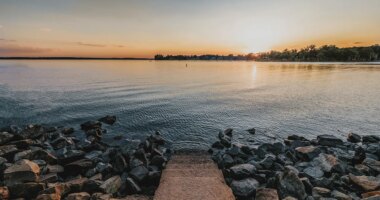Why the mighty Stonehenge was built around 5,000 years ago has long been one of the great mysteries.
But according to a new study, we may finally have an answer.
Scientists say Wiltshire’s famous stone circle was built as a symbol of unification between three distinct corners of Britain.
We know that Stonehenge’s rocky slabs were transported as far afield from southwest Wales and northeast Scotland.
The scientists from University College London and Aberystwyth University propose a theory suggesting that Scottish and Welsh individuals may have transported their own local stones to Wiltshire with the intention of contributing to the construction of Stonehenge.
In that sense, it represented a powerful – and very early – symbol of British unity.
According to the authors of a paper published in Archaeology International, the builders of Stonehenge aimed to promote political unification and a sense of shared identity among the inhabitants of Britain.
They add: ‘Bringing together these extraordinary and alien rocks… symbolised and embodied far and distant communities within a complex material.

Is Stonehenge a symbol of unity for the British people? This renowned stone circle in Wiltshire is not only a globally recognized historic site but also a significant cultural emblem for the British population. Despite its fame, the true purpose of Stonehenge has been a topic of debate among scholars for a considerable amount of time.

The new research comes a day before the winter solstice – the shortest day of the year where thousands of people flock to Stonehenge (pictured in 2021)
‘[Stonehenge was a] monumental expression of unity between people, land, ancestors and the heavens.’
In the paper, the researchers say Stonehenge’s long-distance links add weight to the theory that the Neolithic monument may have had some unifying purpose in ancient Britain, to go with its symbolic value.
‘The fact that all of its stones originated from distant regions, making it unique among over 900 stone circles in Britain, suggests that the stone circle may have had a political as well as a religious purpose,’ said lead author Professor Mike Parker Pearson at UCL’s Institute of Archaeology.
‘[It was] a monument of unification for the peoples of Britain, celebrating their eternal links with their ancestors and the cosmos.’
Even though England, Scotland and Wales did not exist as concepts when Stonehenge was built 5,000-odd years ago, we know the structure is indeed representative of all three countries.
Stonehenge is famous for its great sandstone slabs, known as sarsens, which were sourced locally – likely hauled from West Woods in Wiltshire, around 15 miles north.
But in addition to the tall Sarsen stones that make up Stonehenge’s distinctive appearance, the world-famous site is also home to around 80 ‘bluestones’ – smaller stones that have a bluish tinge when freshly broken or when wet.
Among Stonehenge experts, it is generally agreed the bluestones came from Craig Rhos-y-Felin in the Preseli Hills of south-west Wales (although how exactly they got to Wiltshire is hotly debated).

Researchers say Stonehenge’s Altar Stone (pictured) came from Scotland. Lying flat at the heart, the six-tonne, five-metre-long rectangular Altar Stone is a grey-green sandstone

Meanwhile, around 80 smaller ‘bluestones’ (pictured) – stones that have a bluish tinge when freshly broken or when wet – came from Wales
However, the Altar Stone, the largest bluestone at the centre of Stonehenge, actually came from northern Scotland – up to 1,000km (621 miles) away, scientists revealed earlier this year.
Lying flat at the heart of Stonehenge, the six-tonne, five-metre-long rectangular Altar Stone is a grey-green sandstone, far bigger and different in its composition from the other bluestones.
At the time, the research team (which included two authors of this new paper) analysed the age and chemistry of minerals from fragments of the Altar Stone.
They found a remarkable similarity with the Old Red Sandstone of the Orcadian Basin in northeast Scotland.
The team concluded ‘with 95 per cent accuracy’ that the stone came from this area – which encompasses parts of Inverness, Thurso, Orkney and parts of Shetland – although they’ve since ruled out Orkney as the location.
In this new follow-up paper, the team say the Altar Stone was brought by the Neolithic people of northern Scotland as a contribution or gift to the southerners.
‘[This was] perhaps to cement an alliance or to take part in the extraordinary long-distance collaboration that building Stonehenge represented and embodied,’ the authors say.
Likewise, the bluestones could have been transported by people from the Preseli Hills of south-west Wales as their own contribution – illustrating ‘a political unification or a sacred peace’.

Earlier in 2024, researchers concluded that the Altar Stone came from the Orcadian Basin in northeast Scotland
This follow-up paper now identifies Stonehenge construction ‘as a monument of island-wide unification, embodied in part through the distant and diverse origins of its stones’.
‘Unusually strong similarities in house floor layouts between Late Neolithic houses in Orkney and the Durrington Walls settlement near Stonehenge also provide evidence of close connections between Salisbury Plain and northern Scotland,’ the team say.
Stonehenge was used as a cremation cemetery for mostly adult men and women for around five centuries in its early history.
Nearly half the people buried at Stonehenge had lived somewhere other than Salisbury Plain, the experts say – showing people historically flocked there from afar.
‘The similarities in architecture and material culture between the Stonehenge area and northern Scotland now make more sense,’ added Professor Pearson.
‘It’s helped to solve the puzzle of why these distant places had more in common than we might have once thought.’
The new research comes a day before the winter solstice – the shortest day of the year where thousands of people flock to Stonehenge.
During the winter solstice, the setting sun dips below the horizon over the middle of the Altar Stone and between the two largest upright stones (one of which is now fallen).

Stonehenge is famous for its alignment with the sun, but the ancient monument may have also been carefully designed to align with the movements of the moon

In the northern hemisphere, the summer solstice occurs when Earth’s north is most greatly inclined towards the sun, and the winter solstice occurs when it’s titled away from the sun
For thousands of years, it’s thought people gathered at Stonehenge at both midsummer and midwinter solstices to conduct rituals and ceremonies relating to the changing seasons, the sun and the sky.
During the winter, Neolithic people also feasted close to Stonehenge at the nearby settlement village of Durrington Walls.
Largely because it’s a whopping 5,000 years old, the origins of Stonehenge, including why and how it was built, are still a source of frenzied debate.
Professor Timothy Darvill, an archaeologist at Bournemouth University who passed away earlier this year, said Stonehenge served as an ancient solar calendar, helping people track the days of the year.
The British researcher said the sarsens each represented a single day in a month, making the entire site a huge time-keeping device.
Other theories include that it was a cult centre for healing, a temple or a place where ancestors were worshipped.

















